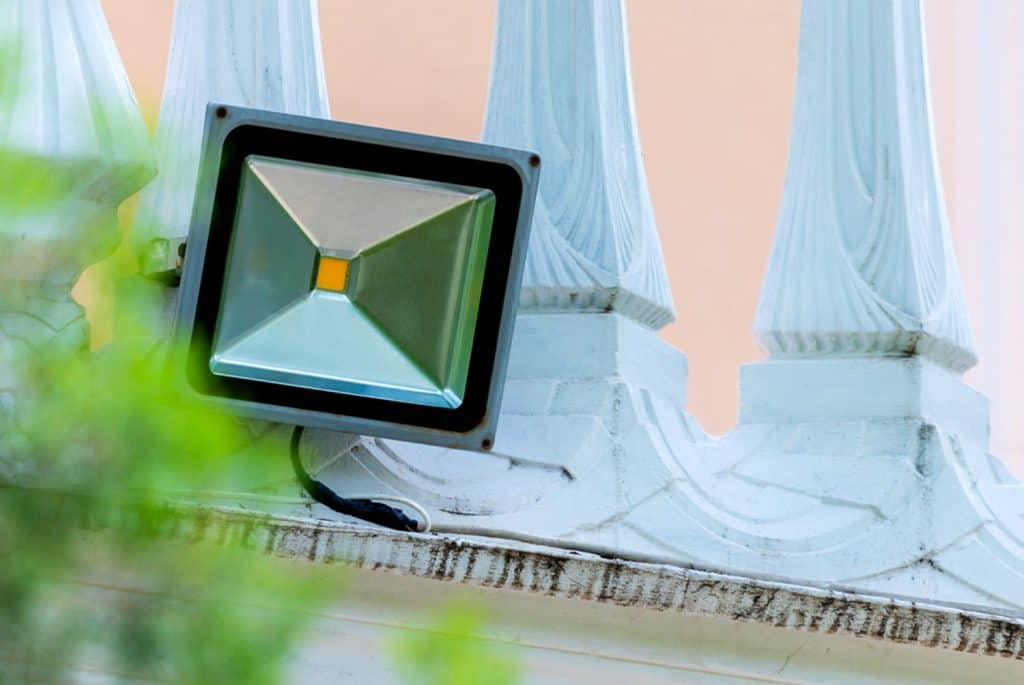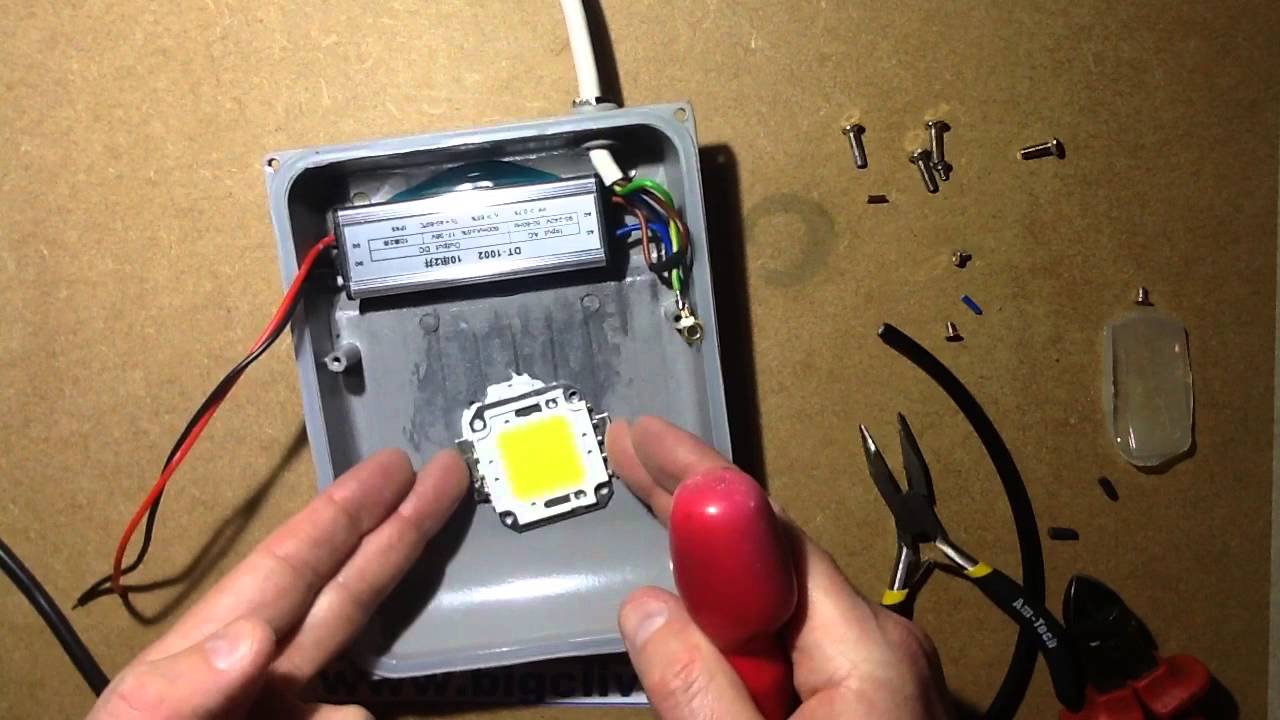Your LED flood light may be blinking due to several reasons:
- Faulty wiring and loose connections
- Faulty LED driver
- Fluctuations in the house’s electrical system, such as a power surge
- Malfunctioning or incompatible dimmer switch
- Overheating
Blinking LED flood lights can be annoying at best and concerning at worst. You’d want your flood lights to be ready for an emergency and blinking lights don’t exactly signal “ready”.
The good news is, many of the potential causes for flickering flood lights can be handily repaired with negligible expenses, if at all. Here are the common reasons for faultily blinking flood lights and how to fix them:
Common Causes of Blinking Flood Lights

It’s best to identify the potential causes for your flood lights flickering before attempting to make any fixes. The most common causes are:
- Wiring issues - Over time, vibrations and external factors can cause the wires to wear or become loose at connection points, interrupting the flow of electricity.
- Faulty LED Driver - The LED driver transforms and regulates power for the LED flood lights. If the LED driver is defective or malfunctioning, it can cause intermittent power to reach the lights resulting in the lights flickering.
- Electrical fluctuations - Power surges and fluctuations in the electrical system can cause your flood lights to flicker. These are usually caused by too many connected electrical devices or a sudden oversupply of power.
- Malfunctioning or incompatible dimmer switch - If you have a dimmer switch controlling the flood lights, it may not be compatible with your flood lights or it may have its own technical issues. These can lead to erratic blinking.
- Overheating - Excessive heat caused by dust, moisture, weather conditions, and wattage issues can cause the flood light’s internal components to malfunction intermittently, leading to blinking.
It’s a good idea to note any anomalies or changes to your electrical system, as these may be affecting your flood lights’ operations. If you’ve had no abrupt changes to your electrical system, then you’ll likely have to inspect the flood light itself to discern the cause.
Here’s more help on troubleshooting blinking flood lights:
8 Effective Solutions to Resolve Blinking Flood Lights

Before attempting to troubleshoot your flood lights, search your specific flood light model online and see if anyone else is having the same issue. Some flood light models may have problems that are unique to that model’s mechanism.
If there are no good results, try the following solutions:
1. Reset the lights
Turn the power to the flood light circuit off at the breaker and leave it off for a few minutes. Then, switch the breaker back on to restore power. Sometimes, resetting the lights in this manner will resolve intermittent blinking issues.
If the flood lights still continue to blink after resetting the breaker, then the problem will require further investigation and repair. But it's worth trying this simple reset first before moving on to more involved troubleshooting steps.
2. Check if the issue is isolated or widespread
Try to determine if the blinking issue is only occurring with one flood light or if multiple flood lights are exhibiting the same problem. This can provide useful clues as to the root cause.
For example, if only one light is blinking, the issue is likely localized to that lighting fixture, wiring, or switch.
However, if all connected flood lights are blinking in unison, it likely points to a more central electrical problem affecting the whole circuit.
3. Check the wiring
Vibrations, weather elements, animals, and normal wear and tear over time can cause wires to wiggle loose from secure connections. They may also become dirty or faulty over time.
Carefully inspect all electrical connections and wires related to the flood light fixture. Make sure wires are securely attached. Also, check for any dirty wires, as accumulated debris can affect their functionality.
If tightening and cleaning your wires don’t resolve the issue, replacing your wires may be worth considering. Be sure to use wires compatible with your flood light model.
4. Make sure the wattage is correct
Ensure that the light bulb or LED module installed in the flood light matches the recommended wattage for the fixture. Using a bulb that is either over or underpowered for the specific fixture can lead to overheating or other issues that cause blinking.
For example, installing a 100W bulb in a fixture rated for 60W can overload the electrical components and wiring, resulting in flickering or intermittent operation as protection mechanisms kick in.
Using the incorrect wattage bulb is an easy mistake to make and simple to fix. Just swap in a bulb rated for the fixture and make sure it stays firmly seated in the electrical contacts.
With the proper wattage bulb installed, the blinking may be resolved.
5. Identify any causes of electrical overloading such as power surges
One common culprit of flickering lights in general is power surges and spikes.
Things like lightning strikes, damage to power lines, and faulty equipment turning on and off can all create momentary power surges. These surges can overload and damage LED driver circuits and other sensitive electronics connected to the lights.
If you think this is the cause of your flood lights’ blinking, you can resolve this in two ways:
- Installing a whole home surge protector - This conditions and regulates power to prevent surges from reaching your electrical system. You can also install a surge protector specifically for the flood light circuit.
- Easing electrical fluctuations - You'll want to rule out any large appliances, machinery, or other equipment that may be cycling on and off in the home. These can create power drains on the system leading to voltage drops that make lights blink.
6. Test with a multimeter
Testing with a multimeter can help rule out or identify electrical problems that visual inspections might miss.
With a multimeter, check the voltage at the flood light terminals to see if power is stable or fluctuating. Also, check for issues like shorts in wires or bad connections that might have high resistance or intermittent contact.
If you're unfamiliar with using a multimeter for diagnosing electrical issues, it may be best to have an electrician take measurements.
7. Replace the LED driver
The LED driver is the component that converts and regulates power from the electrical system to safely operate the LED lights. Like any electronic device, LED drivers can become defective over time leading to issues like intermittent blinking.
If other tried solutions haven’t fixed the problem, it's a good idea to replace the LED driver of your flood light as they are designed to eventually fail.
Make sure to get an LED driver that is compatible with your specific flood light model. You’ll also need to research how to install it for your specific model. If you aren’t confident with the installation process, you can ask a tech-handy friend or electrician to assist you.
8. Swap the dimmer switch
If the flood light is controlled by a dimmer switch, try replacing it with a basic on/off switch or one specifically designed for use with LED lighting.
Many older dimmer switches or rheostats are not fully compatible with LED technology, which can lead to problems like irregular blinking.
LED dimmers have circuitry designed to work with the sensitive electronics in LED lights. So, swapping the switch for an LED-compatible one can potentially fix blinking issues arising from incompatibility.
(Make sure the new switch is rated for the wattage of your flood light).


